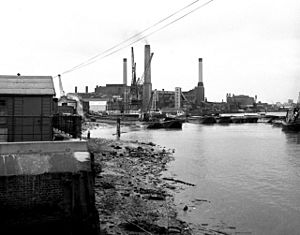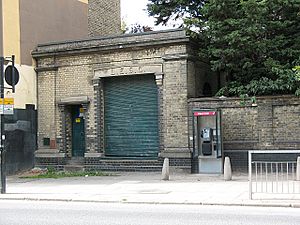Deptford Power Station facts for kids
Quick facts for kids Deptford Power Station |
|
|---|---|

Deptford West Power Station
Viewed from the east in July 1973 |
|
| Country | England |
| Location | Greater London |
| Coordinates | 51°28′57″N 0°01′13″W / 51.4824°N 0.0203°W |
| Status | Decommissioned and demolished |
| Construction began | 1888 (Depford East LP) 1926 (Deptford West) 1947 (Deptford East HP) |
| Commission date | 1891 (Depford East LP) 1929 (Deptford West) 1953 (Deptford East HP) |
| Decommission date | Late 1960s (Deptford East LP) 1972 (Deptford West) 1983 (Deptford East HP) |
| Owner(s) | As operator |
| Operator(s) | London Electric Supply Corporation (1891–1925) London Power Company (1925–1948) British Electricity Authority (1948–1955) Central Electricity Authority (1955–1957) Central Electricity Generating Board (1958–1983) |
| grid reference TQ374778 | |
Deptford Power Station was actually three different power stations built over time in Deptford, London. They were all on the south bank of the River Thames and used coal to make electricity. The very first one, built in 1888, was super important. It's known as the world's first "central" high-voltage power station. This meant it could send electricity over long distances!
Contents
Deptford Power Station: A History of Electricity
Deptford East LP: The First Big Power Station
Imagine a time when electricity was new and exciting! One of the first places in London to get it was the Grosvenor Gallery. This idea came from the Earl of Crawford. He was amazed by an electricity show in Paris in 1881.
A small power plant was built at the Grosvenor Gallery. It was first just for lighting the gallery. But soon, it started supplying nearby shops and homes. A bigger plant opened in 1884. As demand grew, the London Electric Supply Corporation (LESCo) was formed.
LESCo decided to build a new, larger power station in Deptford. This was because people didn't want big power plants in Central London. The Grosvenor Gallery site then became a smaller substation.
This new plan used alternating current (AC) instead of direct current (DC). AC was better because it allowed electricity to be sent at a very high voltage (10,000 volts) from Deptford to the Grosvenor Gallery. The cables were laid next to the London & Greenwich Railway line.
However, early cable designs weren't perfect. This caused the voltage to drop by about 10% over the distance. So, to make sure 10,000 volts arrived, the power station had to send out 11,000 volts. This is why many national electricity voltages later became multiples of eleven!
Building a World First
Sebastian de Ferranti was the engineer for this huge project. The world's first "central" power station opened in Deptford in 1889. "Central" meant it was far from most of its customers. This station was later called Deptford East LP (Low Pressure). It was special because it was so big and used such high voltage for its time.
The station was built on a 3-acre site. It first had two generators. These were powered by two large steam engines, which got their steam from 24 boilers. These boilers burned coal brought by ships from Newcastle.
There were some problems at first, causing shutdowns and losing customers. Ferranti even left in 1891. But the plant was rebuilt with better steam turbines. Soon, the electricity supply became reliable.
Demand for electricity grew steadily. Different types of customers needed different systems:
- Homes and businesses used 83.33-cycle single-phase AC.
- Factories used three-wire DC with two voltage choices.
- Trams and railways used 25-cycle single-phase AC.
By 1923, the station had a total power capacity of 52.5 megawatts (MW). It generated a lot of electricity, selling 46.044 gigawatt-hours (GWh) that year.
Later, Britain switched to a standard 50-cycle three-phase AC system. Deptford East LP was made smaller, keeping only a few 25-cycle turbine-generators. A special machine called The Freak was installed to convert power from the LP station to the 50-cycle National Grid. Deptford East LP closed in the late 1960s.
Deptford West: A New Era of Power
In 1925, many electricity companies, including LESCo, joined together to form the London Power Company. Deptford West was planned by LESCo but built by this new company. Its engineer was Leonard Pearce.
The main building for the turbines was built in an old dry dock. At first, the station had two turbine-generators, many coal-fired boilers, and one large chimney. In the late 1930s, four more turbine-generators and another chimney were added. Some staff even joked that the basement of one generator was haunted! Deptford West closed in 1972.
Deptford West's Electricity Output
Here's how much electricity Deptford West produced each year: Deptford West annual electricity output GWh.<graph>{ "version": 2, "width": 500, "height": 200, "data": [ { "name": "table", "values": [ { "x": 1966, "y": 284 }, { "x": 1967, "y": 173 }, { "x": 1968, "y": 134 }, { "x": 1969, "y": 121 }, { "x": 1970, "y": 147 }, { "x": 1971, "y": 81 }, { "x": 1972, "y": 22 }, { "x": 1954, "y": 720 }, { "x": 1955, "y": 615 }, { "x": 1956, "y": 483 }, { "x": 1957, "y": 442 }, { "x": 1958, "y": 459 }, { "x": 1961, "y": 360 }, { "x": 1962, "y": 340 }, { "x": 1963, "y": 396 }, { "x": 1946, "y": 688 } ] } ], "scales": [ { "name": "x", "type": "ordinal", "range": "width", "zero": false, "domain": { "data": "table", "field": "x" } }, { "name": "y", "type": "linear", "range": "height", "nice": true, "domain": { "data": "table", "field": "y" } } ], "axes": [ { "type": "x", "scale": "x" }, { "type": "y", "scale": "y" } ], "marks": [ { "type": "rect", "from": { "data": "table" }, "properties": { "enter": { "x": { "scale": "x", "field": "x" }, "y": { "scale": "y", "field": "y" }, "y2": { "scale": "y", "value": 0 }, "fill": { "value": "steelblue" }, "width": { "scale": "x", "band": "true", "offset": -1 } } } } ] }</graph>
Deptford East HP: Post-War Power
After World War II, the electricity industry in Britain was taken over by the government in 1948. Power generation then came under the British Electricity Authority. Deptford East HP (High Pressure) opened in 1953.
It had three large turbine-generators, each producing 52.5 MW. It also had many coal-fired boilers and one chimney. The original plan was to make this station even bigger by demolishing the old LP station. However, electricity demand was growing so fast that much larger power plants were needed elsewhere. So, the expansion never happened. The HP station closed in 1983.
Deptford East's Electricity Output
Here's how much electricity Deptford East produced each year: Deptford East annual electricity output GWh.<graph>{ "version": 2, "width": 800, "height": 200, "data": [ { "name": "table", "values": [ { "x": 1966, "y": 535 }, { "x": 1967, "y": 425 }, { "x": 1968, "y": 505 }, { "x": 1969, "y": 570 }, { "x": 1970, "y": 566 }, { "x": 1971, "y": 511 }, { "x": 1972, "y": 434 }, { "x": 1973, "y": 326 }, { "x": 1974, "y": 455 }, { "x": 1975, "y": 384 }, { "x": 1976, "y": 310 }, { "x": 1977, "y": 163 }, { "x": 1978, "y": 310 }, { "x": 1979, "y": 132 }, { "x": 1980, "y": 257 }, { "x": 1981, "y": 87 }, { "x": 1982, "y": 66 }, { "x": 1983, "y": 56 }, { "x": 1954, "y": 317 }, { "x": 1955, "y": 686 }, { "x": 1956, "y": 759 }, { "x": 1957, "y": 768 }, { "x": 1958, "y": 940 }, { "x": 1961, "y": 704 }, { "x": 1962, "y": 723 }, { "x": 1963, "y": 683 }, { "x": 1946, "y": 252 } ] } ], "scales": [ { "name": "x", "type": "ordinal", "range": "width", "zero": false, "domain": { "data": "table", "field": "x" } }, { "name": "y", "type": "linear", "range": "height", "nice": true, "domain": { "data": "table", "field": "y" } } ], "axes": [ { "type": "x", "scale": "x" }, { "type": "y", "scale": "y" } ], "marks": [ { "type": "rect", "from": { "data": "table" }, "properties": { "enter": { "x": { "scale": "x", "field": "x" }, "y": { "scale": "y", "field": "y" }, "y2": { "scale": "y", "value": 0 }, "fill": { "value": "steelblue" }, "width": { "scale": "x", "band": "true", "offset": -1 } } } } ] }</graph>
Deptford Site: A Vital Role in History
The Deptford power station site was important during both World Wars. In 1916, a Zeppelin dropped a bomb, which caused damage and briefly stopped electricity supplies. But workers quickly fixed it! During World War II, the site was hit by bombs again. Sadly, some staff members lost their lives.
In the 1990s, the entire Deptford site was redeveloped. It now has modern apartments. Some parts of the old power station, like walls from the west boiler house, were kept and built into the new structures. The coaling jetty in the Thames, where ships delivered coal, still exists. A nearby park was created and named Ferranti Park, honoring Sebastian de Ferranti, the great engineer.
Power Output Comparison
In the mid-1960s, the Deptford site had a total power output of 448 MW.
| Site | Generators |
|---|---|
| Deptford East LP | About 70 MW from several turbo-alternators. |
| Deptford West | 212 MW from various turbine-generators. |
| Deptford East HP | 166 MW from three turbo-alternators. |
| Deptford Site Total | 448 MW |
To give you an idea, modern power stations like Drax can produce 4,000 MW, and Hinkley Point C can produce 3,200 MW. Even though Deptford was smaller by today's standards, it played a huge role in providing power during the war and helping Britain recover afterwards.
Coal Supply: How the Power Stations Got Their Fuel
The Deptford power stations needed a lot of coal to make electricity. This coal was brought by sea from places like North East England or South Wales. The London Power Company and later government-owned companies had their own fleet of coal ships for this job. These ships, like the SS Francis Fladgate and SS Oliver Bury, were specially designed to carry coal.
Images for kids



